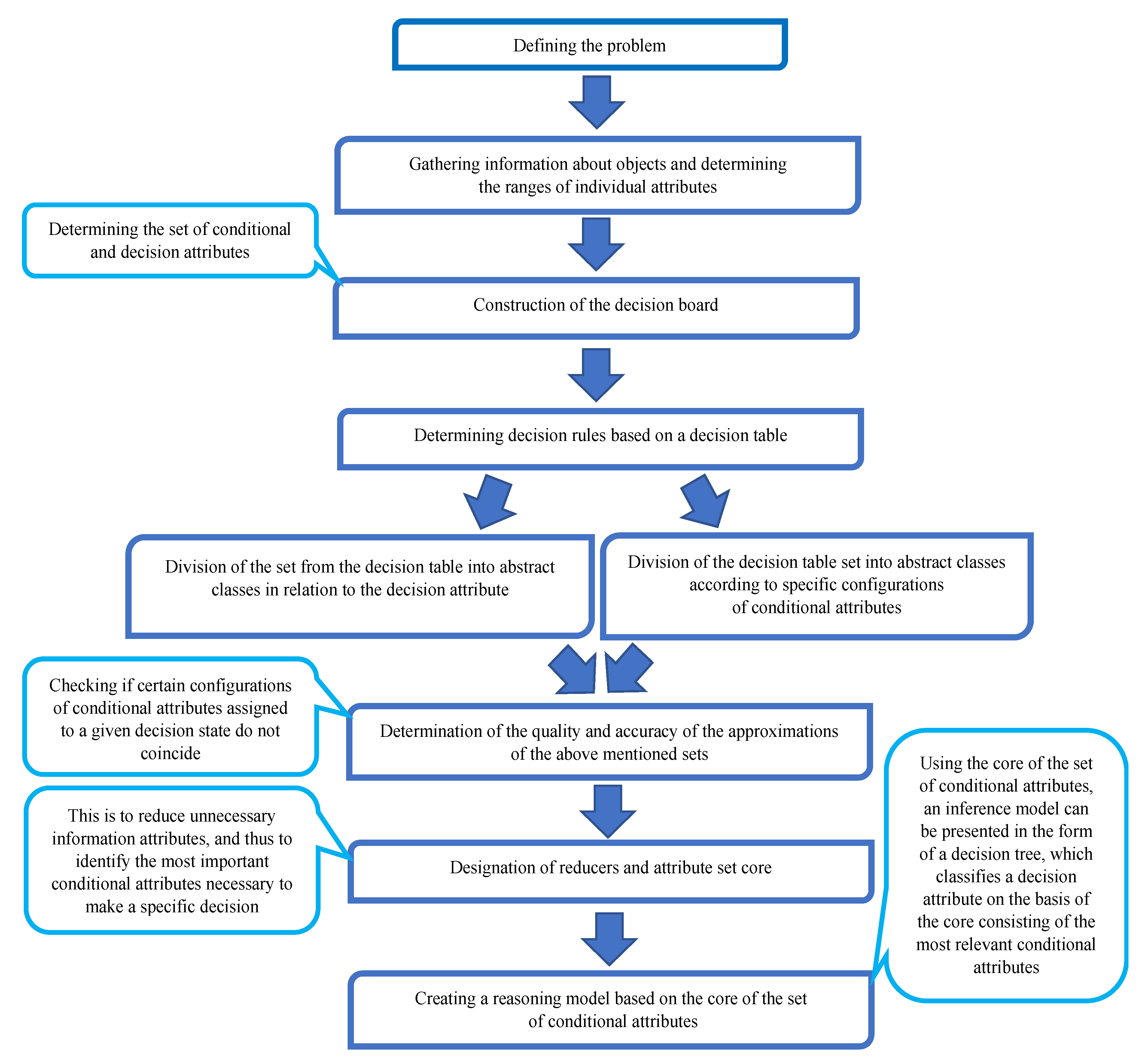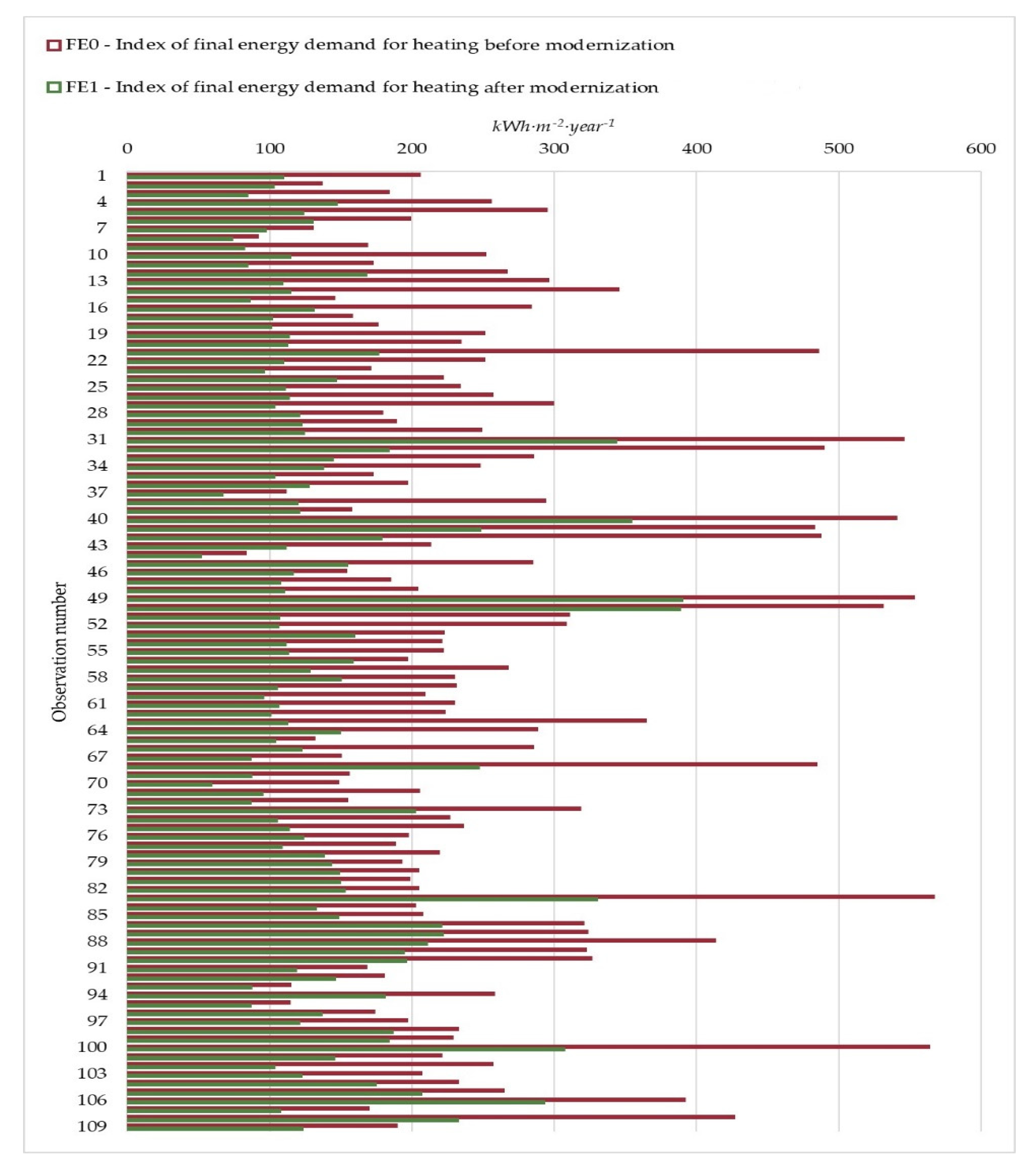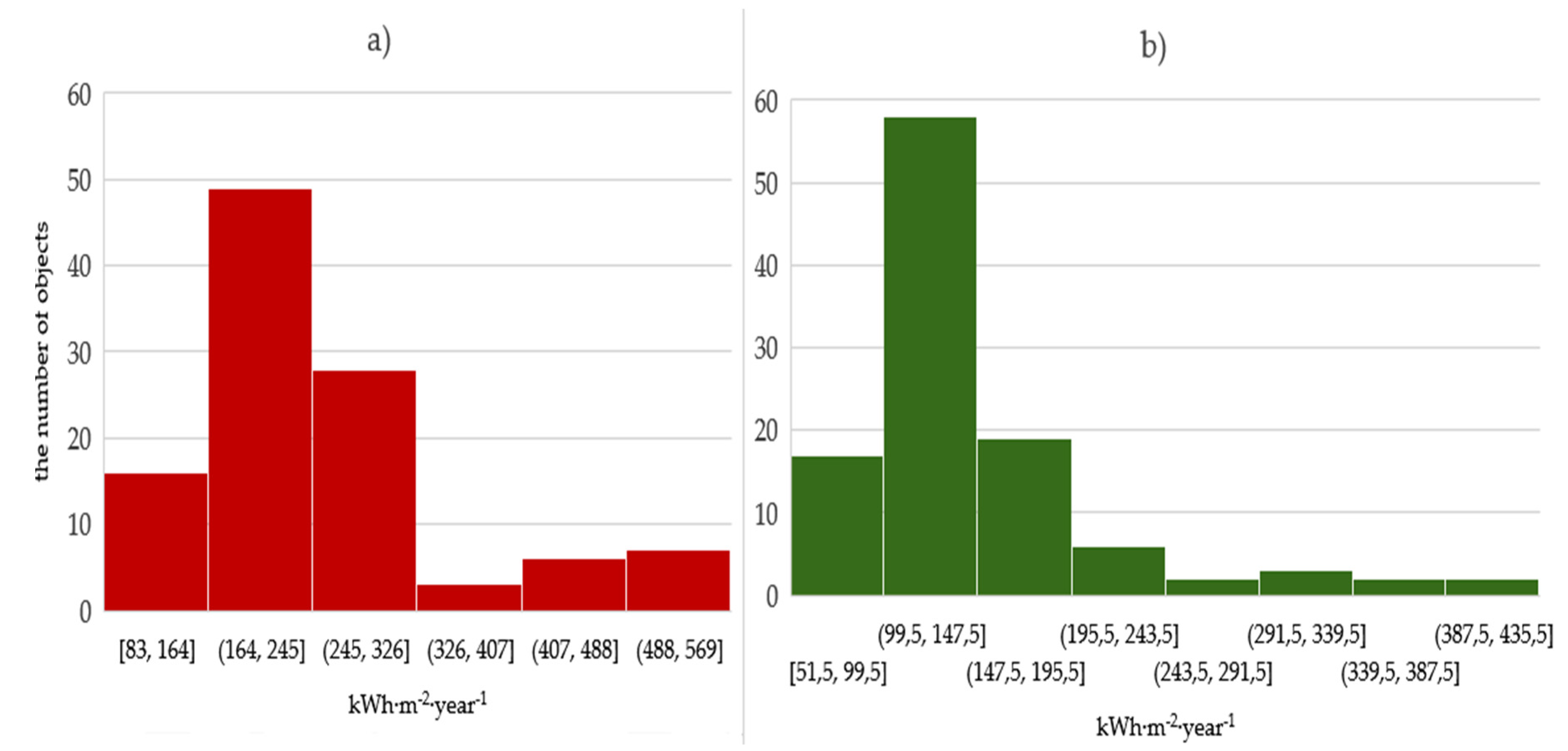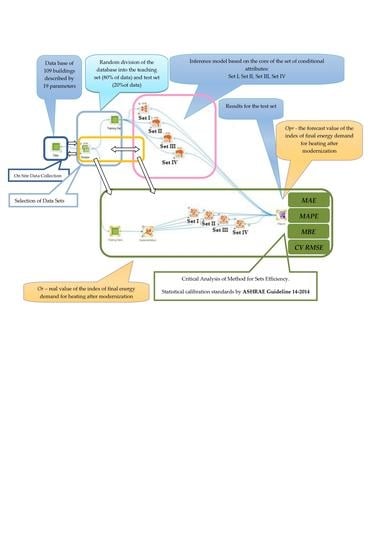Application of Rough Set Theory (RST) to Forecast Energy Consumption in Buildings Undergoing Thermal Modernization
Abstract
:1. Introduction
2. Materials and Methods
3. Results and Discussion
3.1. Analysis of Final Energy Consumption for Heating Buildings
3.2. Modeling the Consumption of Thermal Energy in Buildings Undergoing Energy Modernization
4. Conclusions
- The model developed based on the Rough Sets Theory (RST) is a universal solution that can be used for estimating thermal energy consumption in buildings undergoing thermal improvement. This is evidenced by the results of the assessment, where, according to the ASHRAE Guide, the calibration targets are set at ±10% (MBE) and less than 30% (CV RMSE). The achievement of these thresholds has been demonstrated for three models. These are models based on sets I, II and IV. The best results can be obtained for the model using sets II and I.
- Taking into account all four evaluation indicators, it was found that the best match between the predicted and real values can be obtained if a limited set of input variables (set I) is used in the model, the value of the deviation of the real value from the predicted value (MAE) is amounts to about 22.8 kWh·m−2·year−1, whereas the accuracy of estimation (MAPE) of the model built on the basis of these data is 15.4%. Similar forecasting results can be obtained by using the data set II, but in this case, a greater number of conditional attributes characterizing the building must be available.
- Analyzing the values of MAE and MAPE indicators, it was found that the best results for forecasting energy consumption after thermal improvement can be obtained using the IV set of input variables. The use of this set of variables to build the model allows obtaining the results with the error (MAE) 18.1 kWh·m−2·year−1. This gives an estimated accuracy (MAPE) of 14%. Despite this, this model is recommended as the third in order because of the high value of the MBE indicator, which clearly differs from the others.
- Forecasting the energy consumption of buildings using a model based on Rough Set Theory (RST) using variables that characterize buildings, allows for estimation accuracy of 14.4−15.9%. However, in further research, it is advisable to test this method on a larger, several hundred elementary set of objects (buildings) from different regions, characterized by different climatic conditions from those in which the research was performed, in order to verify the results obtained.
- The examined group of objects should be used to test other forecasting methods so that the results of the estimation can be compared with each other.
Author Contributions
Funding
Acknowledgments
Conflicts of Interest
Nomenclature
| RST | Rough Set Theory |
| MAE | Mean Absolute Error |
| MAPE | Mean Absolute Percentage Error |
| MAPD | Mean Absolute Percentage Deviation |
| MBE | Mean Bias Error |
| CVRMSE | Coefficient of Variation of the Root Mean Square Error |
| Or | real value of the index of final energy demand for heating after modernization (FE1) |
| Opr | the forecast value of the index of final energy demand for heating after modernization |
| ng | number of buildings covered by the study |
| QK,H | final energy demand for the heating season |
| QK,H i | final energy consumption for heating in a measurement period for the “i” of this year |
| HDD(tb)0 | the number of degree days in a standard heating season |
| HDD(tb)i | the number of degree days for the “i” of this year |
| FE | index of final energy demand for heating |
| FE0 | index of final energy demand for heating before modernization |
| FE1 | index of final energy demand for heating after modernization |
| Af | calculated surface of heated floors from interior measurements |
| AH | calculated area of temperature-controlled rooms (heated surface) |
| Ar | calculated from exterior measurements surface of roof projection area (net) |
| Aw | calculated from exterior measurements total walls’ surface (net) area |
| Afl | calculated surface of floor from interior measurements (floor over basement or floor on the ground) |
| Atw | calculated from exterior measurements total windows area |
| Ve | calculated from exterior measurements the heated volume of building |
| S/Ve | shape coefficient of buildings (the ratio surface to volume) |
| NOs | number of stores |
| NOp | number of residential flats, premises |
| NOpb | number of living persons per building |
| Uw | calculated thermal transmittance of walls components |
| Upw | calculated thermal transmittance of peak walls components |
| Ur | calculated thermal transmittance of roof projections components |
| Ug | calculated thermal transmittance of floor components on the ground |
| Uf | calculated thermal transmittance of floors components (floor over basement) |
| Uwin | calculated thermal transmittance of windows (commercial data) |
| Φh | calculated heating consumed power |
References
- Act of 21 November 2008 on Support for Thermal Modernization and Renovation. Available online: http://prawo.sejm.gov.pl/isap.nsf/download.xsp/WDU20082231459/U/D20081459Lj.pdf (accessed on 3 November 2019).
- Directive 2010/31/EU of The European Parliament and of the Council of 19 May 2010 on the Energy Performance of Buildings. Available online: https://eur-lex.europa.eu/legal-content/PL/ALL/?uri=CELEX%3A32010L0031 (accessed on 3 November 2019).
- BGK. Figures of the Thermal Improvement and Repair Fund. 2018. Available online: https://www.bgk.pl/files/public/Pliki/Przedsiebiorstwa/fundusz_kredytu_technologicznego/Dane_liczbowe_FTiR.pdf (accessed on 29 November 2018).
- Bourdeau, M.; Zhai, X.-Q.; Nefzaoui, E.; Guo, X.; Chatellier, P. Modelling and forecasting building energy consumption: A review of data-driven techniques. Sustain. Sustain. Cities Soc. 2019, 48, 101533. [Google Scholar] [CrossRef]
- Fumo, N. A review on the basics of building energy estimation. Renew. Sustain. Energy Rev. 2014, 31, 53–60. [Google Scholar] [CrossRef]
- Foucquier, A.; Robert, S.; Suard, F.; Stéphan, L.; Jay, A. State of the art in building modelling and energy performances prediction: A review. Renew. Sustain. Energy Rev. 2013, 23, 272–288. [Google Scholar] [CrossRef] [Green Version]
- ASHRAE. ASHRAE Handbook–Fundamentals—Energy Estimation and Modeling Methods, SI ed.; American Society of Heating, Refrigerating and Air-Conditioning Engineers, Inc. (ASHRAE): Atlanta, GA, USA, 2009; ISBN 978-1-61583-170-8. Available online: https://app.knovel.com/web/toc.v/cid:kpASHRAE37/viewerType:toc/ (accessed on 5 November 2019).
- Ahmad, T.; Chen, H.; Guo, Y.; Wang, J. A comprehensive overview on the data driven and large scale based approaches for forecasting of building energy demand: A review. Energy Build. 2018, 165, 301–320. [Google Scholar] [CrossRef]
- Tardioli, G.; Kerrigan, R.; Oates, M.; O’Donnell, J.; Finn, D. Data Driven Approaches for Prediction of Building Energy Consumption at Urban Level. Energy Procedia 2015, 78, 3378–3383. [Google Scholar] [CrossRef] [Green Version]
- Yildiz, B.; Bilbao, J.I.; Sproul, A.B. A review and analysis of regression and machine learning models on commercial building electricity load forecasting. Renew. Sustain. Energy Rev. 2017, 73, 1104–1122. [Google Scholar] [CrossRef]
- Wang, J.; Srinivasan, R.S. A review of artificial intelligence based building energy use prediction: Contrasting the capabilities of single and ensemble prediction models. Renew. Sustain. Energy Rev. 2017, 75, 796–808. [Google Scholar] [CrossRef]
- Deb, C.; Lee, S.E. Determining key variables influencing energy consumption in office buildings through cluster analysis of pre-and post-retrofit building data. Energy Build. 2018, 159, 228–245. [Google Scholar] [CrossRef]
- Zhao, H.; Magoulès, F. A review on the prediction of building energy consumption. Renew. Sustain. Energy Rev. 2012, 16, 3586–3592. [Google Scholar] [CrossRef]
- Chang, C.; Zhu, N.; Yang, K.; Yang, F. Data and analytics for heating energy consumption of residential buildings: The case of a severe cold climate region of China. Energy Build. 2018, 172, 104–115. [Google Scholar] [CrossRef]
- Chalal, M.L.; Benachir, M.; White, M.; Shrahily, R. Energy planning and forecasting approaches for supporting physical improvement strategies in the building sector: A review. Renew. Sustain. Energy Rev. 2016, 64, 761–776. [Google Scholar] [CrossRef] [Green Version]
- Mat Daut, M.A.; Hassan, M.Y.; Hasimah, H.A.; Rahman, A.; Abdullah, M.P.; Hussin, F. Building electrical energy consumption forecasting analysis using conventional and artificial intelligence methods: A review. Renew. Sustain. Energy Rev. 2017, 70, 761–776. [Google Scholar] [CrossRef]
- CEN. Indoor Environmental Input Parameters for Design and Assessment of Energy Performance of Buildings Addressing Indoor Air Quality, Thermal Environment, Lighting and Acoustics; ISO 15251. 2008. Available online: https://standards.globalspec.com/std/1110417/EN%2015251 (accessed on 5 November 2019).
- Costanzoa, V.; Fabbrib, K.; Piraccini, S. Stressing the passive behavior of a Passivhaus: An evidence-based scenario analysis for a Mediterranean case study. Build. Environ. 2018, 142, 265–277. [Google Scholar] [CrossRef]
- Djamila, H. Indoor thermal comfort predictions: Selected issues and trends. Renew. Sustain. Energy Rev. 2017, 74, 569–580. [Google Scholar] [CrossRef]
- Wang, Y.; Kuckelkorn, J.; Zhao, F.-Y.; Spliethoff, H.; Lang, W. A state of art of review on interactions between energy performance and indoor environment quality in Passive House buildings. Renew. Sustain. Energy Rev. 2017, 72, 1303–1319. [Google Scholar] [CrossRef]
- CEN. European Standard: Energy Performance of Buildings-Calculation of Energy Use for Space Heating and Cooling. ISO 13790:2008. Available online: https://www.iso.org/standard/41974.html (accessed on 5 November 2019).
- CEN. European Standard: Heating Systems in Buildings; ISO 12831-1:2017-08; CEN: Brussels, Belgium, 2017. [Google Scholar]
- Ballarini, I.; Corrado, V. Application of energy rating methods to the existing building stock. Analysis of some residential buildings in Turin. Energy Build. 2009, 4, 790–800. [Google Scholar] [CrossRef]
- Crawley, D.B.; Lawrie, L.K.; Winkelmann, F.C.; Buhl, W.F.; Huang, Y.J.; Pedersen, C.O.; Strand, R.K.; Liesen, R.J.; Fisher, D.E.; Witte, M.J.; et al. Energyplus: Creating a new-generation building energy simulation program. Energy Build. 2001, 33, 319–331. [Google Scholar] [CrossRef]
- Rivers, N.; Jaccard, M. Combining top-down and bottom-up approaches to energy–economy modeling using discrete choice methods. Energy J. 2005, 26, 83–106. [Google Scholar] [CrossRef] [Green Version]
- Geysena, D.; De Somera, O.; Johanssonc, C.; Bragec, J.; Vanhoudta, D. Operational thermal load forecasting in district heating networks using machine learning and expert advice. Energy Build. 2017, 162, 144–153. [Google Scholar] [CrossRef]
- Allard, I.; Olofsson, T.; Hassan, O.A.B. Methods for energy analysis of residential buildings in Nordic countries. Renew. Sustain. Energy Rev. 2013, 22, 306–318. [Google Scholar] [CrossRef]
- Asadi, S.; Amiri, S.S.; Mottahedi, M. On the development of multi-linear regression analysis to assess energy consumption in the early stages of building design. Energy Build. 2014, 85, 246–255. [Google Scholar] [CrossRef]
- Asadi, S.; Marwa, H.; Beheshti, A. Development and validation of a simple estimating tool to predict heating and cooling energy demand for attics of residential buildings. Energy Build. 2012, 54, 12–21. [Google Scholar] [CrossRef]
- Caldera, M.; Corgnati, S.P.; Filippi, M. Energy demand for space heating through a statistical approach: Application to residential buildings. Energy Build. 2008, 40, 1972–1983. [Google Scholar] [CrossRef]
- Chou, J.S.; Bui, D.K. Modeling heating and cooling loads by artificial intelligence for energy-efficient building design. Energy Build. 2014, 82, 437–446. [Google Scholar] [CrossRef]
- Fumo, N.; Biswas, R. Regression analysis for prediction of residential energy consumption. Renew. Sustain. Energy Rev. 2015, 47, 332–343. [Google Scholar] [CrossRef]
- Lü, X.; Lu, T.; Kibert, C.J.; Viljanen, M. Modeling and forecasting energy consumption for heterogeneous buildings using a physical–statistical approach. Appl. Energy 2015, 144, 261–275. [Google Scholar] [CrossRef]
- Ma, Z.; Li, H.; Sun, Q.; Wang, C.; Yan, A.; Starfelt, F. Statistical analysis of energy consumption patterns on the heat demand of buildings in district heating systems. Energy Build. 2014, 85, 464–472. [Google Scholar] [CrossRef]
- Praznik, M.; Butala, V.; Zbašnik-Senegačnik, M. Simplified evaluation method for energy efficiency in single-family houses using key quality parameters. Energy Build. 2013, 67, 489–499. [Google Scholar] [CrossRef]
- Sekhar-Roy, S.; Roy, R.; Balas, V.E. Estimating heating load in buildings using multivariate adaptive regression splines, extreme learning machine, a hybrid model of mars and elm. Renew. Sustain. Energy Rev. 2018, 82, 4256–4268. [Google Scholar] [CrossRef]
- Tiberiu, C.; Virgone, J.; Blanco, E. Development and validation of regression models to predict monthly heating demand for residential buildings. Energy Build. 2008, 40, 1825–1832. [Google Scholar] [CrossRef]
- Tsanas, A.; Xifara, A. Accurate quantitative estimation of energy performance of residential buildings using statistical machine learning to OLS. Energy Build. 2012, 49, 560–567. [Google Scholar] [CrossRef]
- Biswas, M.; Robinson, M.D.; Fumo, N. Prediction of residential building energy consumption: A neural network approach. Energy 2016, 117, 84–92. [Google Scholar] [CrossRef]
- Ekici, B.B.; Aksoy, U.T. Prediction of building energy consumption by using artificial neural networks. Adv. Eng. Softw. 2009, 40, 356–362. [Google Scholar] [CrossRef]
- Li, K.; Sua, H.; Chua, J. Forecasting building energy consumption using neural networks and hybrid neuro-fuzzy system: A comparative study. Energy Build. 2011, 43, 2893–2899. [Google Scholar] [CrossRef]
- Kumar, R.; Aggarwal, R.K.; Sharma, J.D. Energy analysis of a building using artificial neural network: A review. Energy Build. 2013, 65, 352–358. [Google Scholar] [CrossRef]
- Seyedzadeh, S.; Rahimian, F.; Glesk, I.; Roper, M. Machine learning for estimation of building energy consumption and performance: A review. Vis. Eng. 2018, 6, 5. [Google Scholar] [CrossRef]
- Mihai, M.; Tanasiev, V.; Dinca, C.; Badea, A.; Vidu, R. Passive house analysis in terms of energy performance. Energy Build. 2017, 144, 74–86. [Google Scholar] [CrossRef]
- Pawlak, Z. Rough Sets. Theoretical Aspects of Reasoning about Data; Kluwer Academic Press: Dordrecht, The Netherlands, 2012; Available online: http://bcpw.bg.pw.edu.pl/Content/2026/RoughSetsRep29.pdf (accessed on 5 November 2019).
- TABULA. Polish building typology. In Scientific Report; Narodowa Agencja Poszanowania Energii: Warszawa, Poland, 2012. Available online: https://episcope.eu/fileadmin/tabula/public/docs/scientific/PL_TABULA_ScientificReport_NAPE.pdf (accessed on 15 January 2020).
- Comparison of Typical Buildings from Evaluation of the TABULA Database and Heat Supply Systems 20 European Countries TABULA Evaluation of the Database. Available online: https://episcope.eu/fileadmin/tabula/public/docs/report/TABULA_WorkReport_EvaluationDatabase.pdf (accessed on 15 January 2020).
- Nutech Solution-Science for Business. 2005. Available online: http://www.nutechsolutions.com.pl/ (accessed on 10 October 2019).
- Nguyen, H.S. Tolerance Rough Set Model and Its Applications in Web Intelligence. In Proceedings of the IEEE/WIC/ACM International Joint Conferences on Web Intelligence (WI) and Intelligent Agent Technologies (IAT), Atlanta, GA, USA, 17–20 November 2013; IEEE CS: Washington, DC, USA, 2013; pp. 237–244. [Google Scholar] [CrossRef]
- Nguyen, D.V.; Yamada, K.; Unehara, M. Extended Tolerance Relation to Define a New Rough Set Model in Incomplete Information Systems. AFS 2013, 2013, 372091. [Google Scholar] [CrossRef] [Green Version]
- Renigier-Biłozor, M. Zastosowanie teorii zbiorów przybliżonych do masowej wyceny nieruchomości na małych rynkach (Application of rough set theory for mass valuation of real estate in small markets). Acta Sci. Pol. Adm. Locorum 2008, 7, 35–51. [Google Scholar]
- Szul, T.; Nęcka, K.; Knaga, J. Application of Rough Set Theory to Establish the Amount of Waste in Households in Rural Areas. Ecol. Chem. Eng. S 2017, 24, 311–325. [Google Scholar] [CrossRef] [Green Version]
- Dittmann, P. Prognozowanie w Przedsiębiorstwie; Wolters Kluwer Polska Sp. z o.o.: Kraków, Poland, 2008. [Google Scholar]
- Cieślak, M. Prognozowanie Gospodarcze; Wydawnictwo Naukowe PWN: Warszawa, Poland, 1999. [Google Scholar]
- Ruiz, G.R.; Bandera, C.R. Validation of Calibrated Energy Models: Common Errors. Energies 2017, 10, 1587. [Google Scholar] [CrossRef] [Green Version]
- ASHRAE. ASHRAE Guideline 14-2002 for Measurement of Energy and Demand Savings; American Society of Heating, Refrigeration and Air Conditioning Engineers: Atlanta, GA, USA, 2002. [Google Scholar]
- ASHRAE. American Society of Heating, Ventilating, and Air Conditioning Engineers (ASHRAE). Guideline 14-2014, Measurement of Energy and Demand Savings; Technical Report; American Society of Heating, Ventilating, and Air Conditioning Engineers: Atlanta, GA, USA, 2014. [Google Scholar]
- European Union Statistics, Eurostat. Cooling and Heating Degree Days by NUTS 2 Regions—Annual Data. Available online: http://data.europa.eu/88u/dataset/7kv8vguICyNRJYqLRzzFw (accessed on 30 November 2019).




| No. | Parameter | Abbreviation | Average | Median |
|---|---|---|---|---|
| 1 | calculated surface of heated floors from interior measurements, [m2] | Af | 1567.4 | 1524.2 |
| 2 | calculated area of temperature-controlled rooms (heated surface), [m2] | AH | 1764.0 | 1565.4 |
| 3 | calculated from exterior measurements surface of roof projection area (net), [m2] | Ar | 467.0 | 383.1 |
| 4 | calculated from exterior measurements total walls’ surface (net) area, [m2] | Aw | 1096.6 | 979.8 |
| 5 | calculated surface of floor from interior measurements (floor over basement or floor on the ground), [m2] | Afl | 395.4 | 360 |
| 6 | calculated from exterior measurements total windows area, [m2] | Atw | 290.5 | 251.1 |
| 7 | calculated from exterior measurements the heated volume of building, [m3] | Ve | 6391.6 | 5408.8 |
| 8 | shape coefficient of buildings (the ratio surface to volume), [m2·m−3], [m−1] | S/Ve | 0.46 | 0.42 |
| 9 | number of stores, [pc.] | NOs | 4.3 | 4 |
| 10 | number of residential flats, premises [pc.] | NOp | 32.4 | 29 |
| 11 | number of living persons per building [Nb] | NOpb | 73.9 | 64 |
| 12 | calculated thermal transmittance of walls components, [W·m−2·K−1] | Uw | 1.12 | 1.16 |
| 13 | calculated thermal transmittance of peak walls components, [W·m−2·K−1] | Upw | 1.0 | 0.94 |
| 14 | calculated thermal transmittance of roof projections components, [W·m−2·K−1] | Ur | 1.24 | 0.72 |
| 15 | calculated thermal transmittance of floor components on the ground, [W·m−2·K−1] | Ug | 1.62 | 1.41 |
| 16 | calculated thermal transmittance of floors components (floor over basement), [W·m−2·K−1] | Uf | 1.13 | 1.1 |
| 17 | calculated thermal transmittance of windows (commercial data), [W·m−2·K−1] | Uwin | 1.82 | 1.6 |
| 18 | calculated heating consumed power, [kW] | Φh | 189.2 | 161.2 |
| 19 | measured, the annual heat consumption for building heating converted (according to formula 3) to the conditions of the standard heating season, [MWh·year−1] | QK,H0 | 506.6 | 475.3 |
| Parameter-Condition Attributes | |
|---|---|
| Set I | Φh – calculated heating consumed power, [kW] FE0 – index of final energy demand for heating before modernization, [kWh·m−2·year−1] |
| Set II | Ve – calculated from exterior measurements the heated volume of building, [m3] S/Ve – shape coefficient of buildings (the ratio surface to volume), [m2·m−3], [m−1] Af – calculated surface of heated floors from interior measurements, [m2] Aw – calculated from exterior measurements total walls’ surface (net) area, [m2] Ar – calculated from exterior measurements surface of roof projection area (net), [m2] Atw – calculated from exterior measurements total windows area, [m2] Ain – calculated from interior measurements total (net internal area), [m2] Nopb – number of living persons per building, [Nb] Nop – number of residential flats, premises, [pcs.] FE0 – index of final energy demand for heating before modernization, [kWh·m−2·year−1] |
| Set III | Uw – calculated thermal transmittance of walls components, [W·m−2·K−1] Upw – calculated thermal transmittance of peak walls components, [W·m−2·K−1] Ur – calculated thermal transmittance of roof projections components, [W·m−2·K−1] Uf – calculated thermal transmittance of floors components (floor over basement), [W·m−2·K−1] Uwin – thermal transmittance of windows (commercial data), [W·m−2·K−1] Ug – calculated thermal transmittance of floor components on the ground, [W·m−2·K−1] Ve – calculated from exterior measurements the heated volume of building, [m3] S/Ve – shape coefficient of buildings (the ratio surface to volume), [m2·m−3], [m−1] Af – calculated surface of heated floors from interior measurements, [m2] Aw – calculated from exterior measurements total walls’ surface (net) area, [m2] Ar – calculated from exterior measurements surface of roof projection area (net), [m2] Atw – calculated from exterior measurements total windows area, [m2] Ain – calculated from interior measurements total (net internal area), [m2] Nopb – number of living persons per building, [Nb] Nop – number of residential flats, premises, [pc.] FE0 – index of final energy demand for heating before modernization, [kWh·m−2·year−1] |
| Set IV | Uw – calculated thermal transmittance of walls components, [W·m−2·K−1] Upw – calculated thermal transmittance of peak walls components, [W·m−2·K−1] Ur – calculated thermal transmittance of roof projections components, [W·m−2·K−1] Uf – calculated thermal transmittance of floors components (floor over basement), [W·m−2·K−1] Uwin – thermal transmittance of windows (commercial data), [W·m−2·K−1] Ug – calculated thermal transmittance of floor components on the ground, [W·m−2·K−1] Af – calculated surface of heated floors from interior measurements, [m2] Aw – calculated from exterior measurements total walls’ surface (net) area, [m2] Ar – calculated from exterior measurements surface of roof projection area (net), [m2] Atw – calculated from exterior measurements total windows area, [m2] FE0 – index of final energy demand for heating before modernization, [kWh·m−2·year−1] |
| Assessment Parameters | Sets of variables | |||
|---|---|---|---|---|
| Set I | Set II | Set III | Set IV | |
| MAE [kWh·m−2·year−1] | 22.8 | 23.1 | 25.3 | 18.1 |
| MAPE [%] | 15.4 | 16.4 | 17.8 | 14 |
| MBE [%] | −0.73 | 1.68 | −16 | −9.6 |
| CV RMSE [%] | 21.7 | 18.2 | 32.2 | 18.8 |
© 2020 by the authors. Licensee MDPI, Basel, Switzerland. This article is an open access article distributed under the terms and conditions of the Creative Commons Attribution (CC BY) license (http://creativecommons.org/licenses/by/4.0/).
Share and Cite
Szul, T.; Kokoszka, S. Application of Rough Set Theory (RST) to Forecast Energy Consumption in Buildings Undergoing Thermal Modernization. Energies 2020, 13, 1309. https://doi.org/10.3390/en13061309
Szul T, Kokoszka S. Application of Rough Set Theory (RST) to Forecast Energy Consumption in Buildings Undergoing Thermal Modernization. Energies. 2020; 13(6):1309. https://doi.org/10.3390/en13061309
Chicago/Turabian StyleSzul, Tomasz, and Stanisław Kokoszka. 2020. "Application of Rough Set Theory (RST) to Forecast Energy Consumption in Buildings Undergoing Thermal Modernization" Energies 13, no. 6: 1309. https://doi.org/10.3390/en13061309
APA StyleSzul, T., & Kokoszka, S. (2020). Application of Rough Set Theory (RST) to Forecast Energy Consumption in Buildings Undergoing Thermal Modernization. Energies, 13(6), 1309. https://doi.org/10.3390/en13061309







